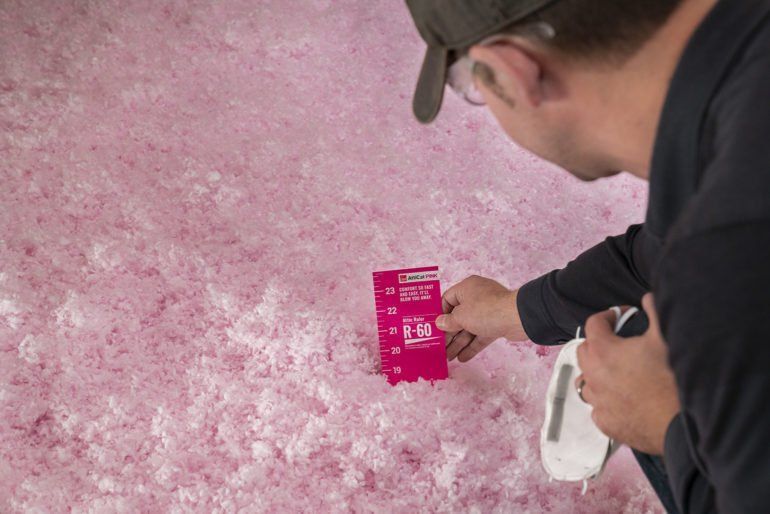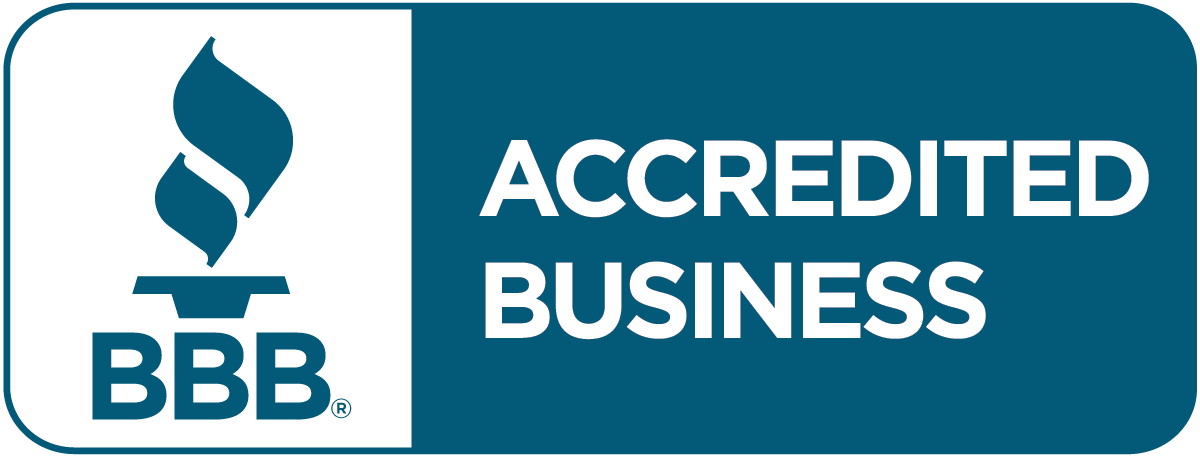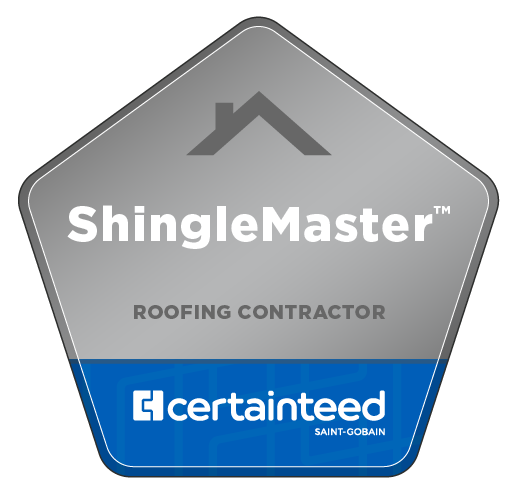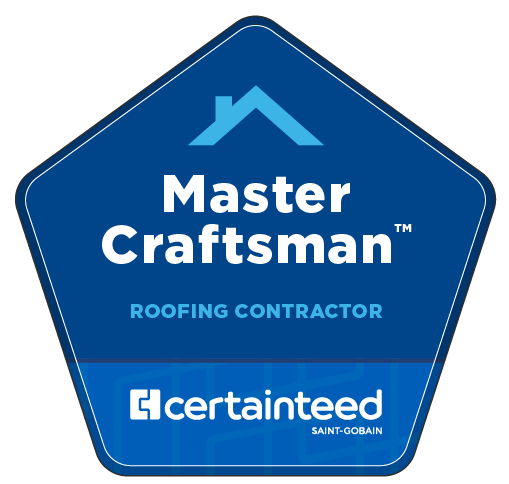Proper Attic Insulation Helps Your Home and Roof
To ensure proper R-Value is achieved, use an R-Value ruler to measure loose fill insulation

The performance of your roof involves more than durable roofing shingles. It takes a complete roofing system—including ventilation and insulation products—to maximize your roof’s performance and durability.
These elements work together to provide additional comfort and help to:
- Extend the life of your roof
- Save money on heating and cooling costs
- Redu ce greenhouse gas emissions.
Attic Ventilation + Insulation = Fewer Roof Problems
The combination of attic insulation and a balanced ventilation system helps keep excessive household moisture and heat out. As a result, the proper conditions and temperature are better maintained in the attic and on the roof deck throughout the year.
Without proper ventilation and insulation, heat and moisture that is trapped in the attic can potentially cause significant damage to your roof and home, such as:
• Ice dams that prevent water runoff
• Premature failure of roofing materials
• Wet wood—sagging roof deck
• Metal rust (nail heads)
• Mold, spores, fungi and mildew
• Interior damage
How Does Attic Ventilation Work?
Attic ventilation is all about removing excess moisture and hot, stagnant air while keeping conditioned air inside the house and out of the attic. Proper ventilation is a critical component of a high-performance roofing system and helps to keep the air inside your home at a comfortable temperature. A properly ventilated attic enables natural, constant air flow, and helps to manage attic temperature and moisture.
In cold temperatures, properly ventilated attics help mitigate ice dams and minimize frost buildup in the attic, while in hot temperatures, they minimize temperatures and excessive moisture.
The ABCs of Ventilation
There are 3 key, universal principles of proper ventilation, which are commonly referred to as the ABCs of ventilation in the building industry:
- A = Ample Amount
- B = Balanced
- C = Control Air Flo w
A = Ample Amount
The Owens Corning vent calculator can provide a general guide on the amount of roof ventilation your home needs.
The International Building Code (IBC) and International Residential Code (IRC) require a minimum ventilation ratio of 1:150 (1 square foot of vent area for each 150 square feet of attic/roof area). If certain requirements are met, such as balanced ventilation, the ratio can be reduced to 1:300. Check local codes for specific requirements. Owens Corning recommends a 1:150 ratio combined with balanced intake and exhaust ventilation for optimum results.
While having an ample amount of vent area is critical, where the vent area is located on the roof is just as important.
The system needs to be balanced.
B = Balanced
Proper ventilation needs a balance of intake and exhaust vents (50% intake, 50% exhaust). Exhaust vents (typically ridge vents or off-ridge vents near the top of your roof) are pulling air out of the attic, which creates negative pressure in the attic without intake vents to make up for the air that is escaping.
Negative pressure sucks – literally.
Intake vents should be installed in soffits or lower on the roof slope near the eaves. If you don’t have at least an equal amount of intake ventilation to balance the exhaust ventilation, then the negative pressure in the attic can suck air from the inside of your home. This means the air you paid to heat or cool inside your home is being pulled into the attic through the ceilings, cracks in the walls, lighting fixtures and/or joints in the framing – making your home uncomfortable, while also wasting energy and money.
Balanced flow helps to keep conditioned air inside the house and out of the attic. Read more about proper attic ventilation.
C = Control Air Flow
Properly air sealing and insulating an attic space can help prevent conditioned air from escaping into the attic, creating a more comfortable home. Insulation saves money on heating and cooling bills and helps to keep the attic temperature where it should be. In the winter, a thick layer of insulation helps keep the heat in the house and out of the attic and helps your house stay cool in the summer.
In addition to insulation, you need to seal air leaks.
Control Air Flow: How Insulation Works
Heat flows from warmer to colder areas until the temperature in both places is the same. In the winter, heat travels from indoor heated spaces to adjacent unheated spaces, such as your attic, garage, basement and even the outdoors.
Insulation works by providing an effective resistance to the flow of heat to other areas. In other words, insulation helps keep your interior, heated rooms warm and toasty while preventing heat from flowing to cooler, unheated spaces.
This application works in reverse in the summer months, with insulation helping to control air flow and contain your cooled air.
R-Value
Insulation resistance to conductive heat flow is expressed as an R-value, which is thermal resistance. In general, the higher the R-value, the greater the effect the insulation has at providing resistance to heat flow.
Increased insulation thickness can increase the R-value. So, if you use loose fill fiberglass insulation in your attic it will be thicker than other types of insulation in order to achieve the same R-value, but this is typically not an issue as attics have room for additional thickness.
One benefit of loose fill insulation is that you can blow-in insulation as thick as you want to achieve any desired R-value.
Minimum R-value levels differ according to building codes and geographical areas. The Department of Energy provides a useful resource on recommendations for floor, wall, and attic insulation in various zones across the United States. Most jurisdictions also enforce an Energy Conservation Code that dictates minimum insulation R-values based on the local climate.
Why You Should Insulate Your Attic
Adding insulation to your attic is good for your roof, your budget, and the planet. Insulating your attic is one of the most effective things you can do to help reduce greenhouse gas emissions.
Sealing Attic Air Leaks Helps Save Energy and Money
Did you know that up to 40% of the air leakage in your home can be through the attic floor?
If your heating and cooling costs are going through the roof (no pun intended), then air sealing the attic floor and adding attic insulation can help cut heating and cooling bills by up to 15%.*
Adding more insulation product to a drafty attic space won’t do much good if you don’t identify and seal up air leaks first.
The air inside our homes typically contains a lot of moisture. Excessive moisture in the attic causes trouble. Seal around cracks and joints to prevent air from escaping into the attic. Dark spots on the roof deck and water stains in the rafters can point to possible openings where air might be leaking into the attic.
If you find signs of water leaking in, get a professional roofing contractor to check the integrity of your roofing system before continuing.
Air leaks typically happen around dropped soffits, through recessed lighting, electrical boxes, and at intersections of floors/ceilings and walls. Owens Corning® ProPink ComfortSeal™ Gun Foam can help homeowners air seal all of these concerns.
If you live in a cold climate area or a region with harsh winters, then you know that heating your house in the winter can get expensive quickly. While some people might try lowering the thermostat a degree or two and throwing on an extra sweater to save money and ward off winter’s chill, this isn’t always an effective strategy.
If your attic space is unfinished, air sealing then adding insulation, such as Owens Corning® Fiberglas™, is one of the most effective things you can do to help keep heating costs down by keeping the heat where it belongs — in the living spaces inside your house.
If you live in a warm climate area or a region with hot summers, then you know the challenges of keeping your home at a comfortable temperature without your air conditioning costs going through the roof. When it comes to outdoor heat, attic insulation helps to stabilize indoor temperatures and keep air-conditioning costs more reasonable.
If you live in an area with COOL roofing standards (such as California) or other energy standards, then you should follow state and local R-value guidelines and install roofing materials, such as COOL roofing shingles, that meet the requirements and comply with all codes and standards in your area.
What is Fiberglass Insulation?
Fiberglass batts and blankets are created from glass fibers. Silica sand, chemicals, and natural minerals make up the building blocks of the molten glass. The resulting material helps reduce the transfer of thermal energy and increases sound absorption.
When choosing your insulation, look for options, such as Owens Corning® EcoTouch® insulation, which uses recycled content and is validated formaldehyde-free.
How to Install Fiberglass Insulation
Fiberglass insulation is one of the simplest insulation products to use. Homeowners can typically install fiberglass batts themselves since they’re easy to unroll and apply to spaces between joists or rafters. Most fiberglass insulation products, like Owens Corning® EcoTouch® PINK® Fiberglas™ Insulation, are available with or without facing and in varying degrees of thicknesses.
If you’re unfamiliar working with insulation or you’re uncertain about which R-value your attic needs, consult a professional to help make sure you install everything correctly.
If you want to install blown-in insulation in your attic yourself, then systems such as the Owens Corning AtticCat® system are easy to use and available to rent from local retailers in your area.
Prior to installing insulation, add baffles like Owens Corning® Raft-R-Mate® at the soffit to keep the ventilation path clear and to help prevent insulation from being blown into the soffit.
Use batt insulation to fill the rest of the opening to the soffit.
Frequently Asked Questions
What is the best type of insulation for an attic?
Fiberglass batts or blown-in, loose fill insulation are good insulation choices for attics. The type of attic insulation you choose depends on the specifics of your home, such as:
- R oof slope
- Ho w easy it is to walk around in your attic space
If you’re not sure about the type of insulation to choose, ask a professional roofing contractor or certified energy professional to help.
How much does it cost to insulate an attic?
The cost to insulate an attic varies primarily on the material you choose. You can investigate prices at your local home improvement center to give you a better idea of the total cost.
Pro Tip: Calculate the square footage of your attic to estimate how much insulation you’ll need for the attic floor.
What R-value do I need for my attic?
The U.S. Department of Energy provides a list of recommended R-values by U.S. Zones and parts of the house. However, you’ll also have to consider local building codes and your contractor’s recommendations.
Is adding fiberglass insulation to my attic worth it?
Absolutely. Proper attic insulation helps to prevent heat from escaping in the winter, and it can help moderate indoor temperatures in the summer, too. In addition to insulating the attic rafters, you should also consider adding insulation to the attic floor if there’s room.
Next Steps to Insulating Your Attic
Adding insulation to your attic is good for your roof, your budget, and the planet. Insulating your attic is one of the most effective things you can do to help reduce greenhouse gas emissions. Adding Owens Corning® PINK Fiberglas™ Blown-In Insulation to your attic can reduce greenhouse gas emissions by over half a ton each year.**
Our insulation products help the environment by reducing the energy required for heating and cooling buildings. We are excited to state that our PINK® Fiberglas™ insulation and AttiCat® PINK® Blown-in products are first to be certified as made with 100% wind-powered electricity1.
Source: Owens Corning
* ENERGY STAR: http://www.energystar.gov/index.cfm?c=home_sealing. hm_improvement_methodology. Savings vary. Find out why in the seller’s fact sheet on R-values. Higher R-values mean greater insulating power.
** Based on an average attic size of 1700 sq. ft. with existing R-19 insulation averaged over 7 cities in diverse climate regions. Savings may vary. †Insulate to local building codes.
1 The three types of insulation available with the wind power certification are EcoTouch® Insulation, Thermafiber® RainBarrier® Continuous Insulation, and Owens Corning® Unbonded Loose-fill Insulation. For more information about the third-party verification process, please visit www.scsglobalservices.com.
Contact Ohio Exteriors Today for Your Home Renovation Needs
If you want top-quality products and uncompromising customer service, make Ohio Exteriors your trusted Columbus contractor today. Call us at
(614) 683-2267 or submit our online request form for more information.









